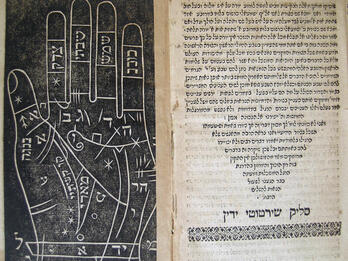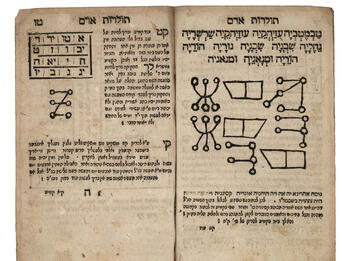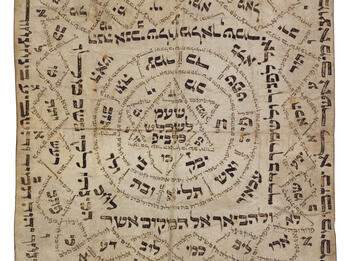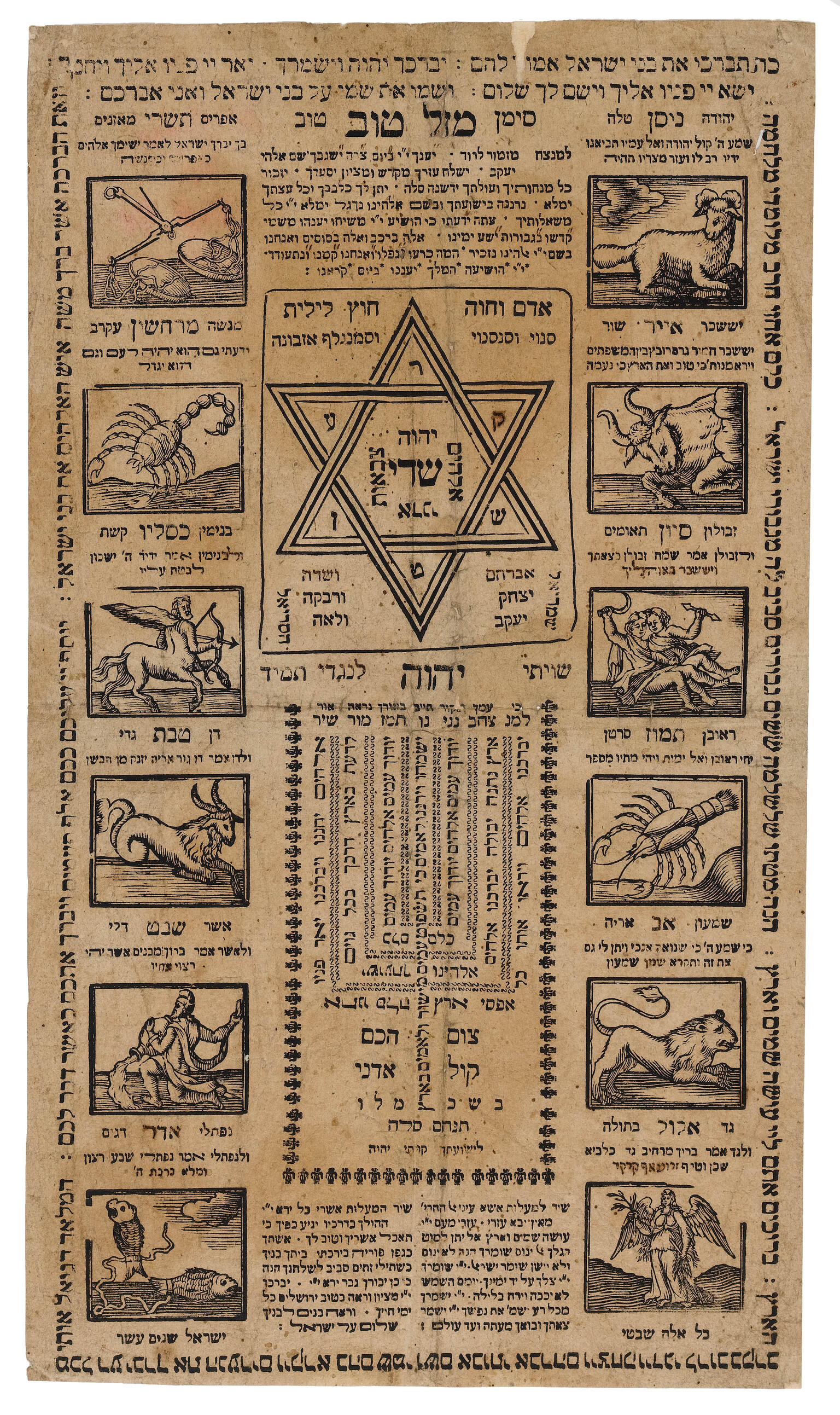Amulet for Woman in Childbirth (Germany)
Artist Unknown
ca. 1725
This early printed amulet from Germany, meant as protection for a woman in childbirth, is adorned with woodcuts illustrating the Hebrew months of the year. The main panel, framed by images of the zodiac, features an inscription banishing the demon Lilith, who, according to folklore, was Adam’s first wife.
Credits
Courtesy GFC Trust / William L. Gross. Photo by Ardon bar Hama.
Published in: The Posen Library of Jewish Culture and Civilization, vol. 5.
You may also like

Zeh ha-sefer toledot Adam (This Is the Book of the Generations of Adam)
The art of chiromancy (palmistry), which divines a person’s nature and often his or her future by examining the palm and fingers (and sometimes forehead), dates back to the ancient Near East and…
Dream Question
A dream question: clean yourself from all impurity and abstain from eating meat, drinking wine, and lying with a woman. And lie in a clean bed after ritually immersing—a stringent immersion, because…

Toledot Adam (The Generations of Adam)
This two-page spread from Elijah ben Moses Loanz’s Toledot Adam (The Generations of Adam) includes examples of some of the kabbalistic amulets and formulae for which he was famous.
!["9. [Image: M9 637 Seder tefilot yesharot u-varot]. Seder Tefilot Yesharot u-barot " Manuscript page of Hebrew text arranged in the shape of a eight-branched candelabrum.](/system/files/styles/entry_card_sm_1x/private/images/vol05/Posen5_blackandwhite165_color.jpg?h=31fc6cc8&itok=ER5JfABc)
Seder tefilot yesharot u-varot (The Order of Upright and Pure Prayers)
Kabbalists prayed using the basic Jewish prayers, but added certain elements according to their own tradition. The prayers are often presented with kavanot (special devotional forms, meanings, and…
![M10 622 Manuscript, probably from Ukraine]. Manuscript probably from Ukraine, c. 1740 with a broad collection of practical kabbalah and mystical magic. Facing page manuscript arranged vertically with Hebrew text in the shape of a figure wielding two long objects.](/system/files/styles/entry_card_sm_1x/private/images/vol05/Posen5_blackandwhite166_color.jpg?h=cec7b3c9&itok=Sz6u21MQ)
Compendium of Practical Kabbalah
This remarkable manuscript of practical kabbalah was written in Eastern Europe in the mid-eighteenth century; at the end of that century it was owned by the Radvil Hasidic dynasty. In contrast to…

Printed Amulet (Germany)
Amulet printed on parchment from Germany. The words in this amulet are arranged to form patterns and shapes.
Engage with this Source
Related Guide
Early Modern Rabbis and Intellectuals on the Move
1500–1750
Carrying books and knowledge, itinerant rabbis and scholars traveled between communities, facilitating cultural exchange.
Related Guide
Early Modern Religious Practices
1500–1750
Early modern Jews both preserved tradition and innovated. Documents and legal texts reveal rich details about synagogue life, marriage, family relations, and death rituals.
You may also like

Zeh ha-sefer toledot Adam (This Is the Book of the Generations of Adam)
The art of chiromancy (palmistry), which divines a person’s nature and often his or her future by examining the palm and fingers (and sometimes forehead), dates back to the ancient Near East and…
Dream Question
A dream question: clean yourself from all impurity and abstain from eating meat, drinking wine, and lying with a woman. And lie in a clean bed after ritually immersing—a stringent immersion, because…

Toledot Adam (The Generations of Adam)
This two-page spread from Elijah ben Moses Loanz’s Toledot Adam (The Generations of Adam) includes examples of some of the kabbalistic amulets and formulae for which he was famous.
!["9. [Image: M9 637 Seder tefilot yesharot u-varot]. Seder Tefilot Yesharot u-barot " Manuscript page of Hebrew text arranged in the shape of a eight-branched candelabrum.](/system/files/styles/entry_card_sm_1x/private/images/vol05/Posen5_blackandwhite165_color.jpg?h=31fc6cc8&itok=ER5JfABc)
Seder tefilot yesharot u-varot (The Order of Upright and Pure Prayers)
Kabbalists prayed using the basic Jewish prayers, but added certain elements according to their own tradition. The prayers are often presented with kavanot (special devotional forms, meanings, and…
![M10 622 Manuscript, probably from Ukraine]. Manuscript probably from Ukraine, c. 1740 with a broad collection of practical kabbalah and mystical magic. Facing page manuscript arranged vertically with Hebrew text in the shape of a figure wielding two long objects.](/system/files/styles/entry_card_sm_1x/private/images/vol05/Posen5_blackandwhite166_color.jpg?h=cec7b3c9&itok=Sz6u21MQ)
Compendium of Practical Kabbalah
This remarkable manuscript of practical kabbalah was written in Eastern Europe in the mid-eighteenth century; at the end of that century it was owned by the Radvil Hasidic dynasty. In contrast to…

Printed Amulet (Germany)
Amulet printed on parchment from Germany. The words in this amulet are arranged to form patterns and shapes.



